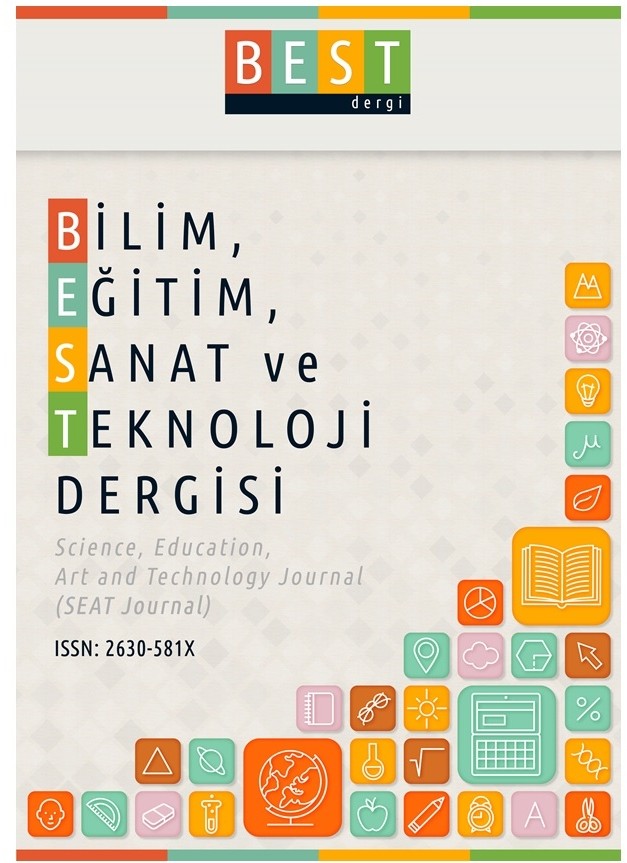Ortaokul Öğrencilerinin Enerji Okuryazarlığının Demografik Değişkenler ile İlişkisinin İncelenmesi
Küreselleşme ve endüstriyel gelişmeler enerjiye olan ihtiyaç giderek artmaktadır. Bunun neticesinde enerji okuryazarı bireyler yetiştirmek için ülkeler eğitimsel, sosyal ve ekonomik politikalar geliştirmektedir. Bu çalışmanın amacı ortaokul öğrencilerin enerji okuryazarlıklarının demografik değişkenler ile ilişkisini incelemektir. İlişkisel tarama modelinin kullanıldığı çalışmaya gönüllü olarak Muğla İlinden 702 ortaokul yedinci sınıf öğrenci katılmıştır. Veriler demografik bilgi formu ile Enerji Okuryazarlığı Ölçeği ile toplanmıştır. Betimsel istatistiklerle beraber veriler bağımsız örneklem t-testleri ve tek yönlü ANOVA testi ile analiz edilmiştir. Bulgular öğrencilerin kendilerini enerji konusunda biraz bilgili olarak tanımladıkları göstermektedir. Katılımcıların enerji okuryazarlığında davranışsal alt boyuta yüksek düzeyde, duyuşsal boyutta orta düzey ve bilişsel boyutta düşük düzeyde oldukları belirlenmiştir. Bağımsız örneklem t-testi sonuçları davranışsal boyutta kızlar ve bilişsel boyutta merkez okullardaki öğrenciler lehine istatistiksel olarak anlamlı farklılık olduğunu göstermiştir. ANOVA sonuçları öğrencilerin bilişsel boyutta anne-baba eğitim seviyesinin önemli olduğunu ve üniversite mezunu ebeveyn çocukları lehine istatistiksel olarak anlamlı fark olduğunu göstermiştir. Bu çalışmanın sonuçları bilişsel boyutta öğrencilerin enerji okuryazarlığı geliştirilmesi için daha fazla çaba harcanması gerektiğini önermektedir.
Anahtar Kelimeler:
Demografik değişkenler, Enerji okuryazarlığı, Nicel yöntemler.
Investigation of the Relationship between Middle School Students' Energy Literacy and Demographic Variables
Globalization and industrial developments increase countries’ need for energy. As a result, countries develop educational, social and economic policies to foster individuals’ energy literacy. The aim of this study was to examine the relationship between middle school students' energy literacy and demographic variables. 702 seventh grade students from Mugla Providence in Turkey voluntarily participated in this relational study. Data were collected with demographic information form and Energy Literacy Scale. Along with descriptive statistics, the data were analyzed with independent t-tests and one-way ANOVAs. Findings showed that students described themselves as somewhat knowledgeable about energy. It was found that the participants had a high level of energy literacy in the behavioral sub-dimension, a moderate level in the affective dimension, and a low level in the cognitive dimension. Independent sample t-test results showed that there was a statistically significant difference in favor of girls in behavioral dimension and in favor of students in central schools in cognitive dimension. The ANOVA results showed that the level of education of the parents was important in the cognitive dimension of the students, and statistically significant difference in favor of the children who had university graduate parents existed. The results of this study suggest that more efforts should be made to develop students' energy literacy in the cognitive dimension.
Keywords:
Demographic variables, Energy literacy, Quantitative methods,
___
- Ayata, S., Oylumluoğlu, G., & Alpaslan, M. M. (2022). Ortaokul Öğrencilerinin Enerji Okuryazarlığının Demografik Değişkenler ile İlişkisinin İncelenmesi [Investigation of the Relationship between Middle School Students' Energy Literacy and Demographic Variables]. Bilim, Eğitim, Sanat ve Teknoloji Dergisi (BEST Dergi) [Science, Education, Art and Technology Journal (SEAT Journal)], 6(2), 115-129.
- Yayın Aralığı: Yılda 2 Sayı
- Başlangıç: 2017
- Yayıncı: Ömer Tayfur ÖZTÜRK
Sayıdaki Diğer Makaleler
Eğitimde Robotik Teknolojiler ve Eğitsel Robotik Uygulamaları
Çevrimiçi Tartışma Forumuna Yapılan Katkı ve Katılımlarının Sosyal Buradalığa Etkisinin İncelenmesi
Ortaokul Öğrencilerinin Enerji Okuryazarlığının Demografik Değişkenler ile İlişkisinin İncelenmesi
Semra AYATA, Görkem OYLUMLUOĞLU, Muhammet Mustafa ALPASLAN
Gamze AVCI, Mukaddes SAKALLI DEMİROK
Ortaokul Öğrencilerinin Çoklu Zeka Alanları ve Müzikten Etkilenme Düzeylerinin İncelenmesi
